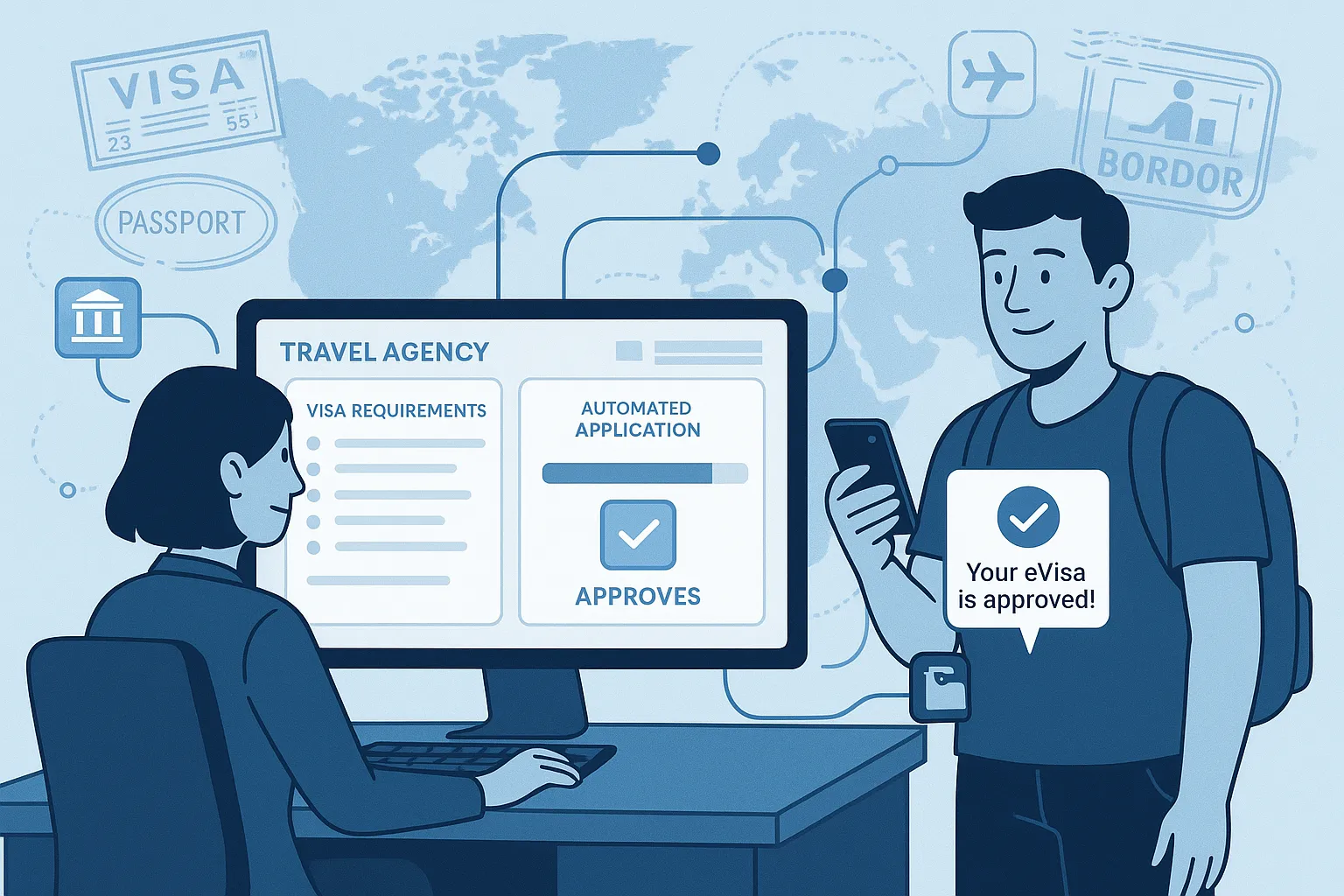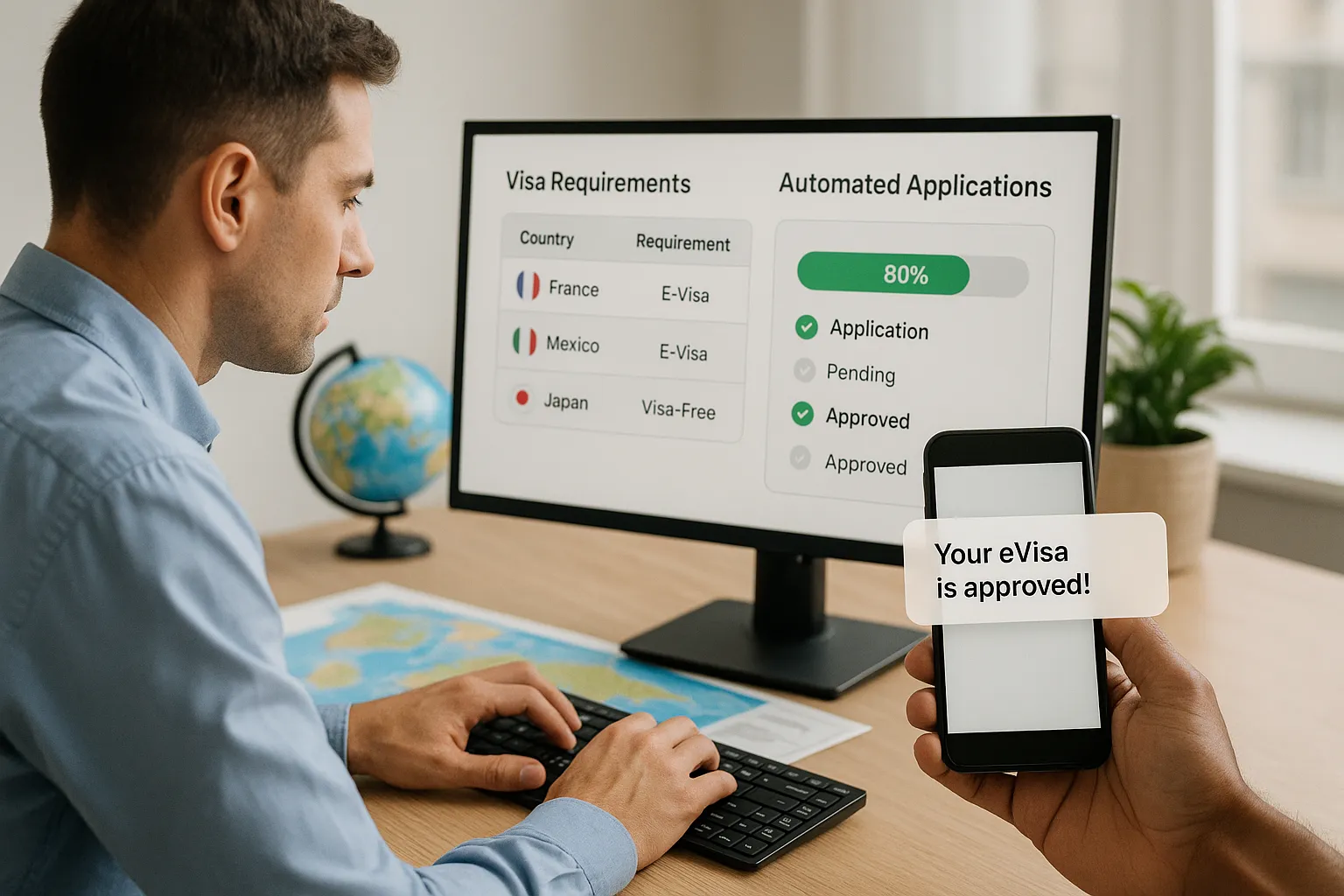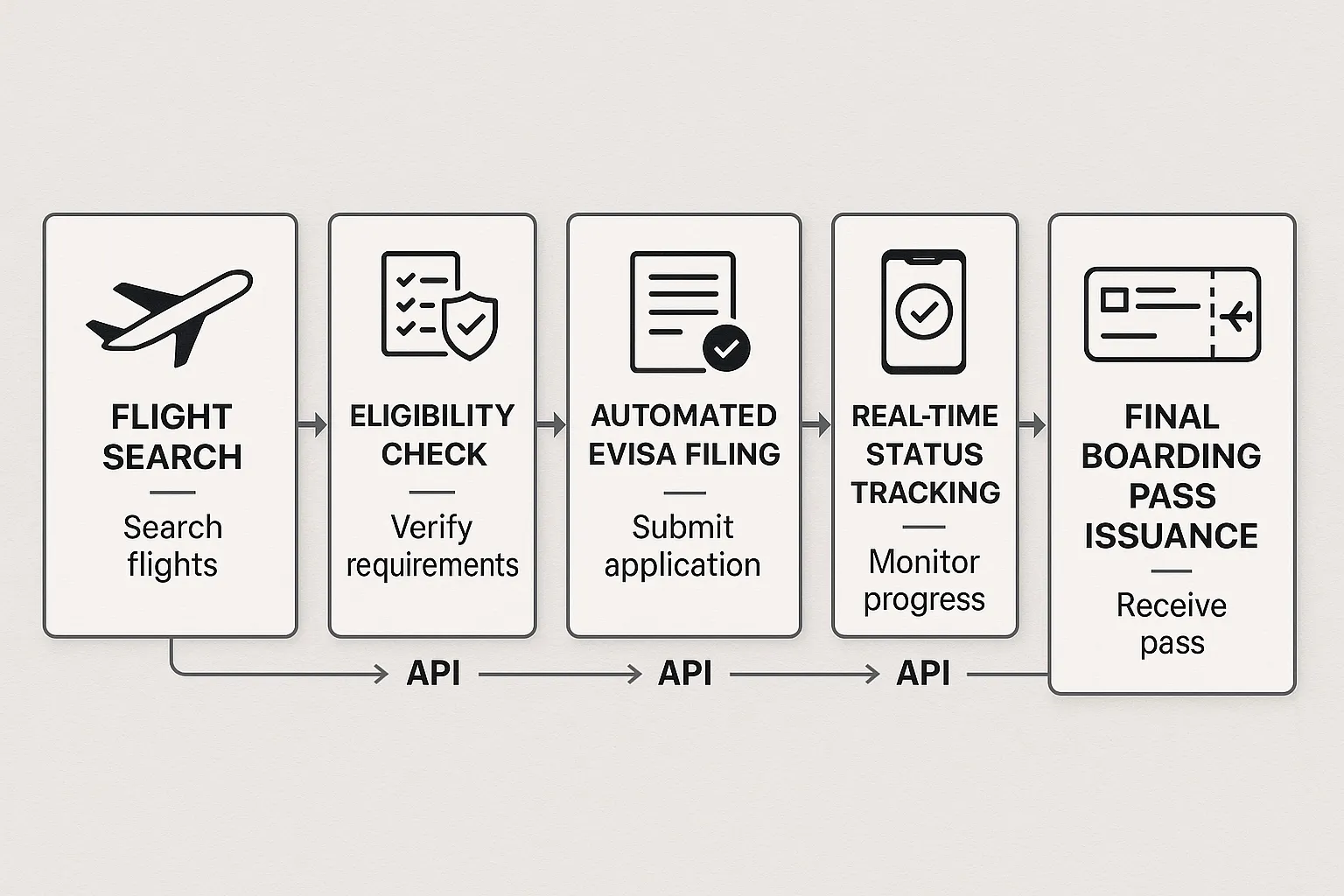Travel Document Automation 101: Choosing the Right Platform for Your Agency

Why travel document automation is no longer optional
Picture a customer who finds the perfect flight on your site, books a hotel in the same session, and then discovers — only at check-in — that she still needs a transit visa. The result: panic, calls to your service center, and often a cancelled trip you worked hard to sell.
Automated visa and border-entry solutions solve this pain point for both travelers and travel sellers. They surface the exact requirements for every itinerary, collect the passenger’s data once, and submit it automatically to the correct government portal. For agencies and OTAs, this means fewer abandoned carts, higher ancillary revenue, and happier, returning customers.
This guide breaks down what travel document automation really is, which features matter, and how to choose a platform that fits the reality of your agency’s workflow in 2025 and beyond.
1. Travel document automation in a nutshell
At its core, a travel document automation platform does three things:
- Rule engine – Consumes real-time government regulations (visas, eTAs, health certificates, transit rules) and returns a clear Yes/No/Additional-Steps answer for each PAX/itinerary combination.
- Application layer – Prefills or fully submits electronic visa or travel authorization forms on behalf of the traveler.
- Status & delivery – Tracks approvals, stores documents, and pushes them back to the PNR, email, or mobile wallet.
Already wondering how the plumbing works? See our explainer on how eVisa APIs work for the technical deep-dive.
2. Key benefits for agencies
- Cart conversion lift: OTAs that expose visa eligibility at search time report up to a 6 % increase in completed bookings (SimpleVisa client data, 2024).
- Ancillary revenue: Service fees on automated visa filing range from US $7 to US $25 per passenger, often with zero acquisition cost because the traveler is already in your funnel.
- Operational savings: Support tickets about “Do I need a visa?” drop by as much as 40 %, freeing your agents for higher-value tasks.
- Customer loyalty: Delivering a valid visa is a tangible service; travelers remember the brand that got them across the border hassle-free.
For a broader view on the commercial upside, read our post on the 3 benefits of a travel visa document system.
3. The decision framework – 7 criteria that matter
Choosing among half a dozen suppliers can feel like alphabet soup: API-only, widgets, white-label apps, B2B dashboards. Use the checklist below to cut through the noise.
1. Coverage & data freshness
- Regulation scope: Visas, ETIAS/ESTA-style authorizations, health declarations, transit waivers.
- Refresh rate: Regulations should update within hours of a government change, not days.
- Edge cases: Mixed-nationality PNRs, cruise segments, land borders.
2. Integration model
- API first: Essential if you own your booking flow and want full UX control.
- No-code widgets: Ideal for smaller agencies that need speed over customization.
- White-label mobile/web app: Lets you upsell after the booking is completed.
SimpleVisa, for instance, offers all three tiers so partners can start light and graduate to an API once volumes justify the dev work.
3. Time-to-market
Ask each vendor: “How many developer days between signing and first live visa?” Platforms that provide pre-built JavaScript snippets or NDC middleware can go live in under two weeks.
4. Compliance & security
- ISO 27001 and SOC 2 certifications
- Encryption at rest and in transit (TLS 1.3)
- Data residency options (EU, US, APAC)
For a closer look at best practices, see How secure is the Electronic Visa System? on our blog.
5. Business model & pricing transparency
- Per-application fee vs. subscription vs. revenue share
- Hidden charges for “premium services” or out-of-hours support?
- SLAs tied to approval rates and response times
6. Customer support & escalation paths
Governments go offline, XML schemas change, travelers mistype passport numbers. Evaluate 24/7 support channels, live dashboards, and fallback procedures.
7. White-label flexibility
- Custom logo and color scheme
- Multilingual UI
- Cross-sell modules (insurance, lounge passes)
A generic interface may do the job, but branding the visa journey keeps your agency front-of-mind.
4. Build vs. buy: a quick cost comparison
| Build in-house | External platform | |
|---|---|---|
| Initial dev effort | 9–12 months | 2–6 weeks |
| Gov portal maintenance | Ongoing | Included |
| Up-front cost | $250-400 k | $0–10 k setup |
| Marginal cost per visa | ~$3-5 infra | $4-10 provider |
| SLA liability | Internal team | Shift to vendor |
Unless you are an airline with a 100-person engineering squad, outsourcing usually wins on speed, risk, and total cost of ownership.
5. Red flags to watch for
- Static rulebooks: If the platform sources rules from PDF manuals that refresh monthly, look elsewhere.
- Opaque approval rates: A vendor unwilling to share live success metrics likely has something to hide.
- Upsell spam: Some providers bombard travelers with unrelated offers, cannibalizing your own ancillary plans.
- Limited language support: English-only interfaces alienate non-native segments.
- Manual back-office steps: If an agent still has to copy-paste data into a government portal, the “automation” label is misleading.
6. Case snapshot – Mid-size OTA goes live in 21 days
Context
• EU-based OTA processing 15 k bookings/month, long-haul heavy.
• 12 % of carts dropped at payment after a visa-eligibility pop-up warned travelers.
Solution
• Implemented SimpleVisa’s eligibility widget in search results.
• Added one-click “Get my visa” upsell post-payment.
Results (first 90 days)
- Booking completion rate +4.8 %
- 2 600 paid visa applications, 92 % approval on first submission
- Ancillary revenue per passenger +US $6.20
- Support tickets about entry rules –32 %
Read the full story inside our Visa Solution Streamline Travel article.
7. Implementation roadmap
- Map the traveller journey: Identify when visa questions arise (search, checkout, post-booking) and inject touchpoints there.
- Define success KPIs: Conversion lift, ancillary revenue, call-center deflection.
- Select integration tier: Widget for MVP, API for scale.
- Run a sandbox test: Use staging credentials to file dummy applications.
- Train customer-facing staff: Quick-reference guides, macro responses.
- Launch and monitor: Track approvals, SLA adherence, and customer feedback.
- Iterate: A/B-test fee levels, messaging, and placement to maximize uptake.
8. Future-proofing: what’s coming next?
- ETIAS rollout: Europe’s new authorization, explained in our ETIAS application process guide, goes live in 2025. Your platform should already support it.
- Digital identity wallets: Expect seamless sharing of verified passport data from Apple/Google wallet APIs.
- AI document parsing: Near-instant photo and passport validation will push approval times from hours to minutes.
- Sustainable travel credentials: Some destinations plan to bundle carbon-offset proof into the same QR code used for e-visa checks.
Choosing a partner with an active product roadmap ensures you don’t have to re-platform every two years.
9. Your next step
Ready to compare solutions? Start with a live demo of SimpleVisa’s API or white-label app and see how quick integration can be. Request yours here: simplevisa.com/request-a-demo.

Automating travel documents is no longer a “nice to have”. It is a revenue lever, a customer-experience differentiator, and soon a compliance necessity. Choose wisely today, and your agency will clear the border hurdles of tomorrow with ease.
